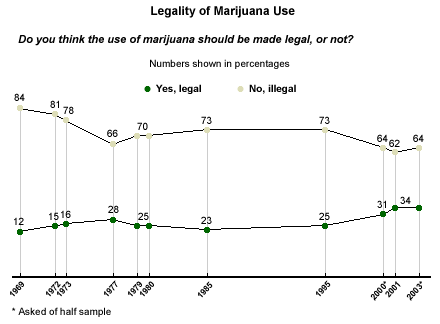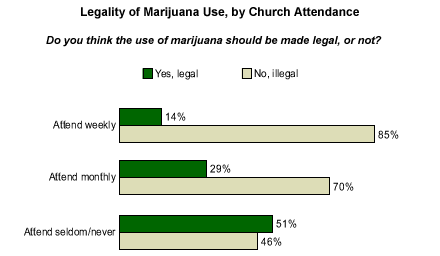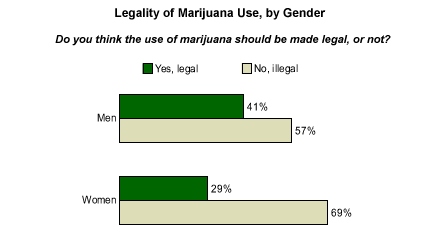U.S. marijuana laws are currently more stringent than those in many other developed countries. For example, while it is against federal law to use or possess marijuana in the United States, Great Britain last month downgraded marijuana possession to a non-arrestable offense, Canada is currently considering civil fines for possession of small amounts, and it is perfectly legal to sell marijuana in Dutch coffee shops.
But although U.S. laws are relatively strict, they do reflect most Americans' attitudes. When asked recently if they think marijuana use should be made legal or remain illegal, just 34% of Americans said it should be made legal, while 64% said it should not*. But the trend toward legality is rising -- the number of people who think marijuana use should be legalized has risen from 12% in 1969, when Gallup first asked the question, to nearly three times that number today.

Within the U.S. population, there is an evident relationship between an individual's degree of religiosity and his or her opinions about legalizing marijuana. Only 14% of Americans who attend religious services weekly said marijuana should be made legal, compared with 51% of those who seldom or never attend.

A significant gender difference also appears among Americans' responses to this question. Women are less inclined than men to support the legality of marijuana use -- 41% of men think marijuana use should be made legal, while only 29% of women think so.

Bottom Line
Groups such as NORML and The Marijuana Policy Project are consistently lobbying Congress for the legalization and decriminalization of marijuana -- and public opinion in favor of such a change is slowly increasing. Still, the federal Controlled Substances Act currently bans the use of all illegal drugs, including marijuana, for both recreational and medical uses -- a prohibition that remains consistent with the views of about two in three Americans.
*Findings are based on telephone interviews with 533 national adults, aged 18 and older, conducted Nov. 10-12, 2003. For results based on the total sample of national Adults, one can say with 95% confidence that the margin of sampling error is ±5 percentage points.
